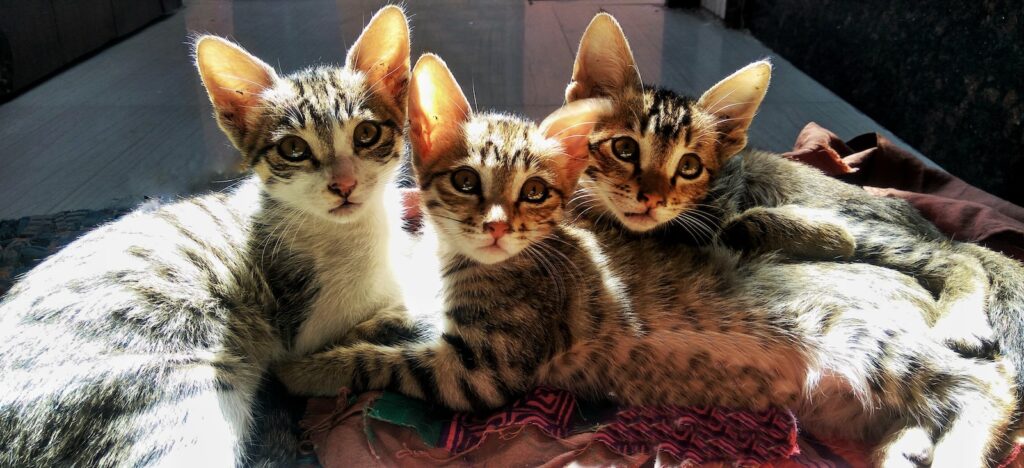Can Cats Eat Rice? — Yes, They Can
When it comes to the question of whether cats can eat rice, the answer is a definitive “yes.” Rice can be a beneficial addition to a cat’s diet, providing them with various nutritional benefits and serving as a source of carbohydrates. However, it is important to incorporate rice into their meals in moderation and ensure it is cooked thoroughly.
Can Kittens Eat Rice?
Yes, kittens can also eat rice. However, it is crucial to introduce small amounts of rice gradually into their diet and monitor their response. As with adult cats, kittens should only consume rice that is fully cooked and properly prepared.
Things to consider when feeding rice to kittens?
When introducing rice to kittens, it is essential to observe their reaction and ensure they do not experience any digestive issues. It is advisable to consult a veterinarian before incorporating rice into their diet, especially if they have any pre-existing health conditions.
Nutritional Benefits of Rice for Cats — Why Rice is Good for Cats?
Fiber Content
Rice contains dietary fiber, which aids in maintaining a healthy digestive system for cats. It helps regulate bowel movements and can be beneficial for cats experiencing constipation or diarrhea. Additionally, fiber promotes satiety, preventing cats from overeating and aiding in weight management.
Energy Source
As a source of carbohydrates, rice provides cats with the energy they need to thrive. Carbohydrates are an essential component of a balanced diet for cats, ensuring they receive the necessary fuel for their daily activities and bodily functions.
Vitamins and Minerals
Rice contains various vitamins and minerals that contribute to a cat’s overall well-being. These include B vitamins, which support energy metabolism, and minerals such as magnesium and selenium, which play vital roles in maintaining optimal health.
Easily Digestible
Unlike some other grains, rice is easily digestible for cats. This makes it a suitable option for cats with sensitive stomachs or those recovering from gastrointestinal issues.
Promotes Hydration
Rice can aid in promoting hydration in cats, especially when served with moisture-rich foods. It absorbs fluids and can contribute to maintaining a cat’s overall hydration levels.
Potential Allergies: Can Cats Be Allergic to Rice?
While rice is generally well-tolerated by cats, some individuals may develop allergies or sensitivities to this grain. It is crucial to observe any adverse reactions after introducing rice to your cat’s diet.
Symptoms of Rice Allergies in Cats
- Vomiting or Diarrhea: Cats experiencing an allergic reaction to rice may exhibit gastrointestinal symptoms such as vomiting or diarrhea.
- Skin Irritation: Some cats may develop skin irritations, such as itching, redness, or rashes, if they are allergic to rice.
- Respiratory Issues: In rare cases, cats may experience respiratory difficulties, including coughing or sneezing, as a result of a rice allergy.
What to Do If Your Cat Shows Symptoms?
- Consult Your Veterinarian: If you suspect that your cat is having an adverse reaction to rice, it is crucial to seek veterinary advice for proper diagnosis and guidance.
- Elimination Diet: Your veterinarian may recommend performing an elimination diet to identify the specific food allergen causing the symptoms.
- Alternative Diet Options: If your cat is diagnosed with a rice allergy, your veterinarian can suggest alternative diet options that meet their nutritional needs.
Recommended Amount: How Much Rice Can a Cat Consume?
The recommended amount of rice for a cat’s diet varies depending on various factors, including their age, weight, and overall health. It is important to consult with a veterinarian to determine the appropriate portion size and frequency of rice inclusion in their meals.
Things to Consider When Feeding Rice to Cats
When feeding rice to cats, it is crucial to avoid adding any seasoning, spices, or oil. Plain, cooked rice is the safest option for cats, as additives and flavorings can be harmful to their digestive system. Additionally, ensure that rice is not their primary source of nutrition and is incorporated alongside a balanced cat food diet.
How to Feed Rice to Cats: A Quick Guide
Introducing rice to your cat’s diet can be done by following these simple steps:
Kitty Rice Delight
To create a delightful rice treat for your feline companion, follow these steps:
- Cook plain rice according to package instructions. Ensure it is fully cooked and free of any seasoning.
- Allow the cooked rice to cool down to room temperature.
- Mix a small amount of cooked rice with your cat’s regular wet or dry food.
- Observe your cat’s response to the rice and monitor their digestion.
- If your cat enjoys the rice and digests it without any issues, you can gradually increase the amount as per your veterinarian’s recommendation.
Conclusion
In conclusion, rice can be a safe and beneficial addition to a cat’s diet. It provides essential nutrients, aids in digestion, and can serve as an energy source. However, it is essential to introduce rice gradually, monitor your cat’s response, and ensure it is cooked plain without any additives. If your cat shows any adverse symptoms, consult with your veterinarian for appropriate guidance. Remember to prioritize a balanced cat food diet while incorporating rice into their meals.






